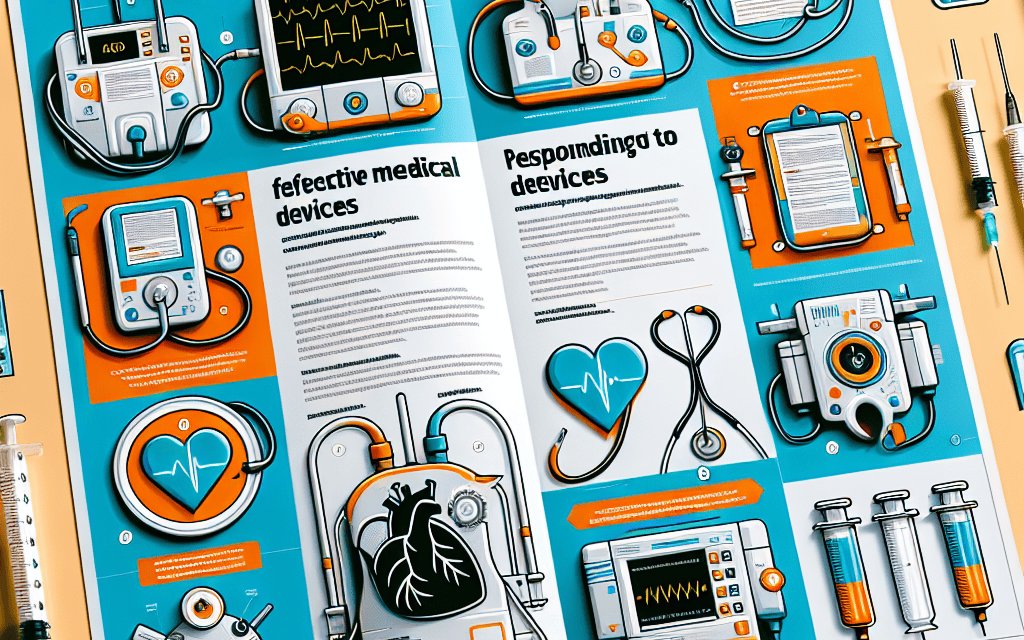Identifying and Responding to Defective Medical Devices: A Guide
Medical devices play a crucial role in modern healthcare, ranging from simple tools like thermometers to complex machinery like MRI machines. However, when these devices malfunction or are found to be defective, they can pose serious risks to patient safety. This article aims to provide a comprehensive guide on identifying and responding to defective medical devices, covering essential aspects such as regulatory frameworks, common types of defects, reporting mechanisms, case studies, and preventive measures.
Understanding Medical Device Regulations
The regulation of medical devices is a critical aspect of ensuring patient safety and efficacy. In the United States, the Food and Drug Administration (FDA) is the primary regulatory body overseeing medical devices. The FDA categorizes devices into three classes based on their risk levels:
- Class I: Low-risk devices that are subject to the least regulatory control. Examples include bandages and handheld surgical instruments.
- Class II: Moderate-risk devices that require more regulatory controls to ensure safety and effectiveness. Examples include infusion pumps and X-ray machines.
- Class III: High-risk devices that require premarket approval due to their potential to cause significant harm. Examples include pacemakers and implantable defibrillators.
The FDA’s regulatory framework includes several key components:
- Premarket Notification (510(k)): Manufacturers must demonstrate that their device is substantially equivalent to a legally marketed device.
- Premarket Approval (PMA): Required for Class III devices, this process involves rigorous testing and clinical trials to ensure safety and effectiveness.
- Post-Market Surveillance: Once devices are on the market, the FDA monitors their performance and safety through various mechanisms, including mandatory reporting of adverse events.
Understanding these regulations is essential for healthcare professionals and patients alike, as it provides a framework for identifying potential defects and understanding the responsibilities of manufacturers and regulatory bodies.
Common Types of Defective Medical Devices
Defective medical devices can manifest in various ways, leading to different types of risks. Understanding these common defects can help healthcare providers and patients identify issues early on. Some prevalent types of defects include:
- Design Defects: Flaws in the design of a device that make it inherently unsafe. For example, a surgical instrument that is difficult to handle may lead to unintended injuries.
- Manufacturing Defects: Errors that occur during the production process, such as contamination or incorrect assembly. A notable case is the recall of certain lots of surgical mesh due to manufacturing errors that led to high rates of complications.
- Labeling Defects: Inadequate or misleading information on device labels can lead to misuse. For instance, if a device does not clearly state its intended use, it may be used incorrectly, resulting in harm.
- Performance Defects: Devices that do not perform as intended can lead to serious health risks. For example, a malfunctioning insulin pump may deliver incorrect dosages, putting patients at risk of hyperglycemia or hypoglycemia.
- Software Defects: As medical devices become increasingly reliant on software, bugs or vulnerabilities can lead to significant issues. The recall of certain infusion pumps due to software vulnerabilities is a prime example.
Each of these defects can have serious implications for patient safety. For instance, a study published in the Journal of Patient Safety found that nearly 1 in 10 patients experienced an adverse event related to a medical device, highlighting the importance of vigilance in identifying potential defects.
Reporting Mechanisms for Defective Medical Devices
When a defective medical device is identified, it is crucial to report it through the appropriate channels. The FDA has established several mechanisms for reporting adverse events and device defects:
- MedWatch: The FDA’s Safety Information and Adverse Event Reporting Program allows healthcare professionals and patients to report adverse events related to medical devices. Reports can be submitted online, by mail, or by fax.
- Manufacturer Reporting: Medical device manufacturers are required to report certain adverse events to the FDA within specific timeframes. This includes serious injuries, deaths, and device malfunctions that could lead to serious injury or death.
- Voluntary Reporting: Healthcare professionals and patients are encouraged to report any adverse events, even if they are not mandatory. This helps the FDA identify trends and potential safety issues.
In addition to these mechanisms, healthcare facilities often have their own internal reporting systems. It is essential for healthcare providers to be familiar with these systems and to encourage patients to report any concerns they may have about their medical devices.
Case studies illustrate the importance of reporting. For example, the recall of the DePuy ASR hip implant was partly triggered by reports from patients and healthcare providers about high failure rates. The timely reporting of these issues allowed the FDA to take action and protect patients from further harm.
Case Studies of Defective Medical Devices
Examining real-world examples of defective medical devices can provide valuable insights into the consequences of defects and the importance of vigilance. Here are a few notable case studies:
- DePuy ASR Hip Implant: In 2010, Johnson & Johnson’s DePuy Orthopaedics recalled its ASR hip implant after reports indicated that nearly 13% of patients required revision surgery within five years. The recall highlighted the importance of post-market surveillance and the need for manufacturers to monitor the long-term performance of their devices.
- Medtronic Infuse Bone Graft: Medtronic faced scrutiny over its Infuse Bone Graft product, which was linked to serious complications, including excessive bone growth and nerve damage. The case raised questions about the adequacy of clinical trials and the ethical responsibilities of manufacturers in reporting adverse events.
- Boston Scientific’s Guidant Heart Devices: In the early 2000s, Guidant (acquired by Boston Scientific) faced multiple recalls of its implantable cardioverter-defibrillators (ICDs) due to battery failures. The company was criticized for delaying the recall and failing to adequately inform patients and healthcare providers about the risks.
These case studies underscore the importance of transparency, timely reporting, and regulatory oversight in ensuring patient safety. They also highlight the need for healthcare providers to remain vigilant and proactive in identifying potential defects in medical devices.
Preventive Measures and Best Practices
Preventing defects in medical devices requires a multifaceted approach involving manufacturers, healthcare providers, and regulatory bodies. Here are some best practices that can help mitigate risks:
- Rigorous Testing and Quality Control: Manufacturers should implement stringent testing protocols and quality control measures throughout the production process. This includes preclinical testing, clinical trials, and post-market surveillance to identify potential issues early on.
- Training and Education: Healthcare providers should receive ongoing training on the proper use and maintenance of medical devices. This includes understanding the potential risks and recognizing signs of malfunction.
- Patient Engagement: Patients should be educated about their medical devices, including how to use them safely and what to watch for in terms of potential defects. Encouraging patients to report any concerns can help identify issues early.
- Collaboration with Regulatory Bodies: Manufacturers should maintain open lines of communication with regulatory bodies like the FDA. This includes promptly reporting adverse events and collaborating on post-market studies to monitor device performance.
- Utilizing Technology: Advances in technology, such as remote monitoring and data analytics, can help identify potential defects before they lead to serious issues. For example, some devices now have built-in alerts that notify healthcare providers of malfunctions.
By implementing these preventive measures, stakeholders can work together to enhance the safety and efficacy of medical devices, ultimately protecting patient health.
Conclusion
Identifying and responding to defective medical devices is a critical aspect of patient safety in healthcare. Understanding the regulatory framework, recognizing common types of defects, utilizing reporting mechanisms, learning from case studies, and implementing preventive measures are all essential components of this process. As medical technology continues to evolve, it is imperative for healthcare providers, manufacturers, and patients to remain vigilant and proactive in addressing potential defects. By fostering a culture of safety and transparency, we can work together to ensure that medical devices serve their intended purpose without compromising patient health.
In summary, the key takeaways from this guide include:
- The importance of understanding medical device regulations and classifications.
- Common types of defects that can occur in medical devices and their implications for patient safety.
- The various reporting mechanisms available for identifying and addressing defective devices.
- Real-world case studies that highlight the consequences of defects and the importance of timely reporting.
- Best practices and preventive measures that can help mitigate risks associated with medical devices.
By staying informed and engaged, we can contribute to a safer healthcare environment for all.





